Scarlet macaw
The scarlet macaw (Ara macao) is a large red, yellow, and blue Central and South American parrot, a member of a large group of Neotropical parrots called macaws. It is native to humid evergreen forests of tropical Central and South America. Range extends from south-eastern Mexico to the Peruvian Amazon, Ecuador, Colombia, Bolivia, Venezuela and Brazil in lowlands of 500 m (1,640 ft) (at least formerly) up to 1,000 m (3,281 ft). In some areas, it has suffered local extinction because of habitat destruction or capture for the parrot trade, but in other areas it remains fairly common. Formerly it ranged north to southern Tamaulipas. It can still be found on the island of Coiba. It is the national bird of Honduras. Like its relative the blue-and-yellow macaw, scarlet macaws are popular birds in aviculture as a result of their striking plumage.
| Scarlet macaw | |
|---|---|
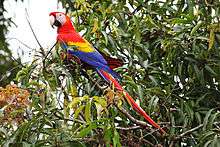 | |
| Scarlet Macaw | |
| Scientific classification | |
| Kingdom: | Animalia |
| Phylum: | Chordata |
| Class: | Aves |
| Order: | Psittaciformes |
| Family: | Psittacidae |
| Genus: | Ara |
| Species: | A. macao |
| Binomial name | |
| Ara macao | |
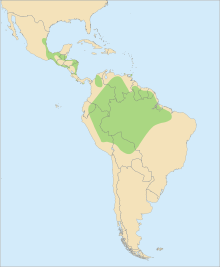 | |
Extant distribution of the scarlet macaw | |
| Synonyms | |
|
Psittacus macao Linnaeus, 1758 | |
Taxonomy
The scarlet macaw was formally described by the Swedish naturalist Carl Linnaeus in 1758 in the tenth edition of his Systema Naturae under the binomial name Psittacus macao.[2] The scarlet macaw is now placed in the genus Ara (Lacépède, 1799), one of 6 genera of Central and South American macaws.[3]
The two subspecies can be recognized by size and color detail in the feathers on the wings:[3]
- A. m. Macao (Linnaeus, 1758): South American scarlet macaw, the nominate subspecies. In the wings the medium and secondary coverts have green tip.
- A. m. Cyanopterus Wiedenfeld, 1995: North Central American scarlet macaw. The Central American scarlet macaw is larger and has blue on its wings instead of green.
It is about 81 centimeters (32 in) long, of which more than half is the pointed, graduated tail typical of all macaws, though the scarlet macaw has a larger percentage of tail than the other large macaws. The average weight is about 1 kilogram (2.2 lb). The plumage is mostly scarlet, but the rump and tail-covert feathers are light blue, the greater upper wing coverts are yellow, the upper sides of the flight feathers of the wings are dark blue as are the ends of the tail feathers, and the undersides of the wing and tail flight feathers are dark red with metallic gold iridescence. Some individuals may have green in the wings.

There is bare white skin around the eye and from there to the bill. Tiny white feathers are contained on the face patch. The upper mandible is mostly pale horn in color and the lower is black. Juveniles have dark eyes; adults have light yellow eyes.
It is frequently confused with the slightly larger green-winged macaw, which has more distinct red lines in the face and no yellow in the wing.
Scarlet macaws make very loud, high and sometimes low-pitched, throaty squawks, squeaks and screams designed to carry many miles to call for their groups.
The scarlet macaw can live up to 75[4] or even 90[5] years in captivity, although a more typical lifespan is 40 to 50 years.[5][4]
Genetics
In May 2013 it was announced that a team of scientists, led by Dr. Christopher M. Seabury and Dr. Ian Tizard of Texas A&M University had sequenced the complete genome of the scarlet macaw.[6][7]
Behavior
A typical sighting is of a single bird or a pair flying above the forest canopy, though in some areas flocks can be seen. They may gather at clay licks.[8] Scarlet macaws communicate primarily through raucous honks; however, vocal communication is highly variable, and captive macaws are known to be adept mimics of human speech.
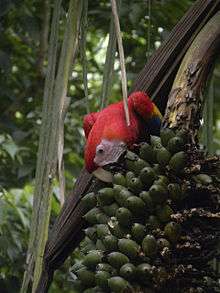
Feeding
They also love to eat insects and larvae.They are seen feeding heavily on bugs, snails and foliage. Snails and bugs are great source of protein, as they need additional protein during breeding seasons. They also add flowers and nectar to their diet as a supplement[9]
Breeding
While comparatively docile at most times of the year, scarlet macaws may be formidably aggressive during periods of breeding. Scarlet macaws are monogamous birds, with individuals remaining with one partner throughout their lives. The hen lays two or three white eggs in a tree cavity. The female incubates the eggs for about five weeks, and the chicks fledge from the nest about 90 days after hatching.[10] and leave their parents about a year later. Juveniles reach sexual maturity at five years of age.
Distribution and habitat
The South American range is extensive and covers the Amazon forest ; extending to Peru east of the Andes, to Bolivia.[11] In Bolivia, it is very present in the Aquicuana Reserve, located in the Beni Department, near the city of Riberalta, the Capital of the Bolivian Amazon.
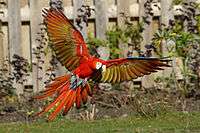
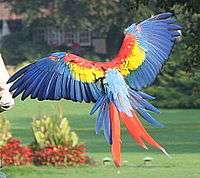
In Central America, the range extends from extreme eastern and southern Mexico and Panama through Guatemala and Belize, the island of Coiba and infrequently on the mainland of Panama, and in Costa Rica in isolated regions on the Pacific Coast; the Nicoya Peninsula the Carara National Park and Peninsula de Osa.
The scarlet macaw has escaped or been deliberately released in to Florida, but there is no evidence that the population is breeding and may only persist due to continuing releases or escapes.[12]
Scarlet macaws inhabit humid lowland subtropical rain forests, open woodlands, river edges, and savannas.
Conservation status
The habitat of scarlet macaws is also considered to have the greatest latitudinal range for any bird in the genus Ara, as the estimated maximum territorial range covers 6,700,000 km2. Nevertheless, the scarlet macaw's habitat is fragmented, and the bird is mostly confined to tiny populations scattered throughout its original range in Middle America.[13] However, as they still occur in large numbers over most of their original range in South America, the species is classified by IUCN as least concern.[1]
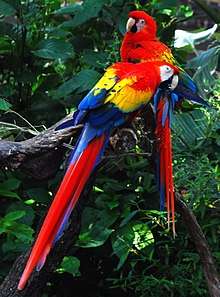
It is listed on CITES Appendix 1 due to predation for the pet and cage bird trade.[14] Both subspecies are listed by USFWS as endangered.[15]
Aviculture
The scarlet macaw is an early example of a parrot breeding in captivity. Captive breeding occurred in Northern Mexico at Paquime (also called Casas Grandes) and very likely Southwest New Mexico Mimbres Valley in the 11th century. Breeding pens, perches, bones, and eggshell fragments have been uncovered. The straightforward nature of scarlet macaw breeding and the value of their plumes in trade created a market for trade wherein the animals were used in religious rites north to the Colorado Plateau region.
Today the scarlet macaw is found worldwide in captivity, but is best represented in captivity in the Americas. Captive techniques developed from the pet trade have positively affected wild populations: in areas with low macaws populations, the "extra" babies that typically die in the nest may be reared by humans hands and released into the wild to bolster the population, as has been done by the Tambopata Macaw Project. Their captive diet, egg incubation, assisted hatching, hand rearing, co-parenting, parent-rearing, fledgling, maturation, and breeding are well understood within the avicultural community (AFA Watchbird magazine).
See also
- The Ara Project (macaw reintroduction)
- List of macaws
- Iago (Disney)
References
- BirdLife International (2012). "Ara macao". IUCN Red List of Threatened Species. 2012. Retrieved 26 November 2013.CS1 maint: ref=harv (link)
- Linnaeus, Carl (1758). Systema Naturæ per regna tria naturae, secundum classes, ordines, genera, species, cum characteribus, differentiis, synonymis, locis (in Latin). Volume 1 (10th ed.). Holmiae:Laurentii Salvii. p. 96.
- Gill, Frank; Donsker, David, eds. (2017). "Parrots & cockatoos". World Bird List Version 7.3. International Ornithologists' Union. Retrieved 22 November 2017.
- Scarlet Macaw at the biology website of the Lamar University (retrieved 2019-02-24)
- Robert Arking: Biology of Aging: Observations and Principles. Oxford University Press, 2006, ISBN 9780199727629, p. 129
- Seabury, Christopher M.; Dowd, Scot E.; Seabury, Paul M.; Raudsepp, Terje; Brightsmith, Donald J.; Liboriussen, Poul; Halley, Yvette; Fisher, Colleen A.; Owens, Elaine; Viswanathan, Ganesh; Tizard, Ian R. (8 May 2013). "A Multi-Platform Draft de novo Genome Assembly and Comparative Analysis for the Scarlet Macaw (Ara macao)". PLoS ONE. 8 (5): e62415. Bibcode:2013PLoSO...862415S. doi:10.1371/journal.pone.0062415. PMC 3648530. PMID 23667475.
- "Save the Parrots: Texas A&M Team Sequences Macaw Genome". Newswise.com. Retrieved 1 October 2013.
- Photo of Scarlet Macaws and several other parrots at clay-lick in Tambopata-Candamo – The Wonders of Peru with Boyd Norton.
- macaw, scarlet. "diet and nutrition". scarlet macaw. scarlet macaw.
- Alderton, David (2003). The Ultimate Encyclopedia of Caged and Aviary Birds. London, England: Hermes House. p. 234. ISBN 1-84309-164-X.
- "Ara macao (Scarlet Macaw)". IUCN Red List of Threatened Species. 2012-05-01. 2012-05-01. Retrieved 2015-03-19.
- "Nonnatives - Scarlet Macaw". myfwc.com.
- Juniper, T., and M. Parr., (1998). Parrots: A Guide to Parrots of the World. Yale University Press.
- "Scarlet Macaw". Species Database: CITES-Listed Species. UNEP-WCMC. Retrieved May 17, 2007.
- "Species Profile".
External links
| Wikimedia Commons has media related to Scarlet macaw. |
| Wikispecies has information related to Scarlet macaw |
- Scarlet Macaw in-depth research article.
- Tambopata Macaw project long term research project in south east Peru
- World Parrot Trust Parrot Encyclopedia — Species Profiles
- Scarlet macaw videos on the Internet Bird Collection
- Page of photographs of Scarlet and green-winged macaws at a clay lick from Parrots International
- Scarlet macaw photo on PBase
- Stamps (15 countries) with RangeMap
- Ara macao conservation and reintroduction in Costa Rica
- Scarlet macaw in illegal traffic in Nicaragua
- The Scarlet Macaw Genome Project
- Scarlet macaw information

